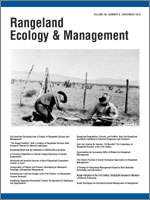Restoration activities are directed toward a broad spectrum of targets. Identifying a restoration target entails defining an ecosystem state and its desired functioning that can be attained through managerial interventions. First, we discuss how restoration targets must integrate economic, social, and ecological considerations in order to be feasible. Primary challenges to identifying realistic restoration targets include long-term managerial and fiscal commitments as well as the accommodation of inherent rangeland complexities stemming from social and ecological factors. Second, we illustrate how the existing tools of ecological site description, rangeland health assessment, and state-and-transition modeling present opportunities to identify flexible restoration targets. Last, we describe how to refine these targets using adaptive management in order to cope with constraints and to reduce the uncertainty of ecosystem dynamics typical of complex systems. Restoration should be viewed as both a rangeland management activity and a means to inform and guide interventions within a specific site.
Las actividades de rehabilitación están dirigidas hacia un amplio espectro de objetivos. La identificación de un objetivo de rehabilitación implica la definición del estado del ecosistema y el funcionamiento deseado que puede alcanzarse a través de intervenciones de manejo. Primero, discutimos cómo los objetivos de rehabilitación deben integrar factores económicos, sociales y ecológicos, con el fin de ser factibles. Los principales desafíos para la identificación de objetivos realistas de rehabilitación incluyen compromisos de manejo y económicos a largo plazo. Así también deben incluirse otros elementos innatos de los pastizales derivados de los factores sociales y ecológicos. Segundo, ilustramos cómo la existencia de herramientas para descripción ecológica de los sitios, evaluación del bienestar del pastizal, y el modelado del estado y transición representan oportunidades para identificar objetivos de rehabilitación. Finalmente, describimos cómo redefinir estos objetivos usando manejo adaptativo con el fin de hacer frente a limitaciones y reducir la incertidumbre de la dinámica de los ecosistemas típicamente de los sistemas complejos. La rehabilitación debe ser vista tanto como una actividad del manejo de pastizales como de un medio para informar y guiar las mediaciones en un sitio especifico.





